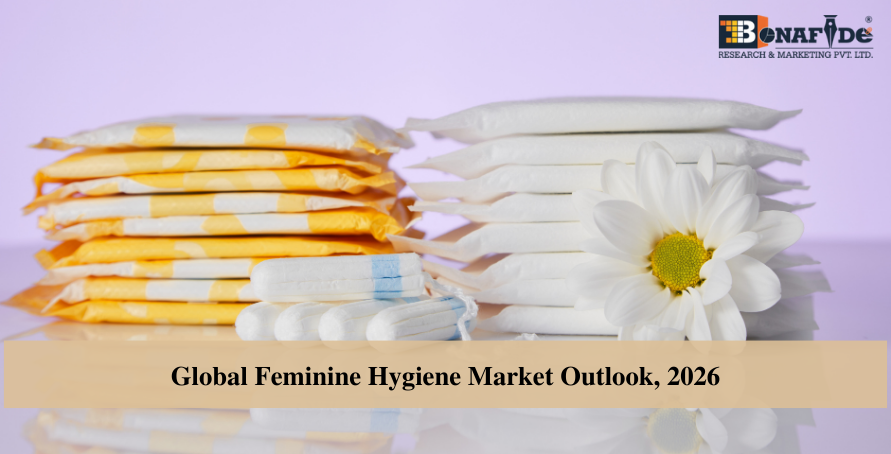

Female Menstrual Hygiene is vital to the empowerment and well-being of women and girls worldwide. It is about more than just access to sanitary pads and appropriate toilets – though those are important. It is also about ensuring women and girls live in an environment that values and supports their ability to manage their menstruation with dignity. Globally, at least 500 million women and girls lack proper access to menstrual hygiene facilities. Several factors influence difficult experiences with menstruation, including inadequate facilities and materials, menstrual pain, fear of disclosure, and inadequate knowledge about the menstrual cycle.
The report Global Feminine Hygiene Market Outlook, 2026 recently published by Bonafide Research has categorically been divided into sections namely by product, type, distribution channel, region, country, and company. The global feminine hygiene products market is projected to show a growth of USD 31.60 Billion between 2015 and 2026. Increasing female population & rapid urbanization, rising female literacy and awareness of menstrual health & hygiene, rising disposable income of females, and women empowerment are expected to accelerate the growth of the feminine hygiene products market across the globe.
To avail of the sample report for free: https://www.bonafideresearch.com/samplereport/210419911/global-feminine-hygiene-market
By type, the sanitary napkins segment accounted for the largest share of the feminine hygiene products market in 2019, at more than 60%. A sanitary napkin is a type of feminine hygiene product that is worn externally, unlike tampons and menstrual cups, which are worn inside the vagina. The large share of the sanitary napkins segment can be attributed to increased awareness compared to other feminine hygiene products, along with easy availability. The retail pharmacies segment is expected to gain maximum share in terms of value among all distribution channels whereas the supermarket segment is expected to be the second most lucrative segment over the forecast period. The supermarket segment is contributing higher revenue share due to the increasing infrastructure and purchasing power of people in urban countries.
The Asia Pacific accounted for the largest share of the feminine hygiene products market in 2019. The large share can be attributed to the high female population in countries such as India and China. Both these countries are expected to account for a combined market share of over 60% of the region by 2026, while globally it is likely to contribute less than 33%. Growing disposable income, rapid urbanization, and awareness about menstrual hygiene management are driving the feminine hygiene products market in this region. Recently, the Indian government announced plans to invest USD 160 million in the Suvidha initiative, a scheme to ensure proper access to sanitary napkins in rural areas of the country. The government plans to provide biodegradable sanitary napkins to the masses at the cost of USD 0.00014 through this scheme. The government plans to involve high net worth individuals (HNIs) and corporates to assist in distributing sanitary napkins to underprivileged women across the country. These developments will further boost the demand for feminine hygiene products.
Literacy is a fundamental right and a springboard for eradicating poverty and broadening the mindset of society. The relationship between literacy and health has been the focus of much research and policy debates. The rising literacy level among females is expected to have a positive impact on overall feminine health management and thus is directly linked to the adoption of feminine hygiene products. As a result, rising female literacy is expected to drive the feminine hygiene products market.
The common perception and stigma associated with menstruation act as a major disadvantage for many women. Girls face stigma, harassment, and social exclusion during menstruation. This compels girls and women to adopt traditional feminine hygiene products or completely avoid using them. Women in some countries have had to rely on scraps of fabric to absorb menstrual blood due to the prohibition of the use of tampons and sanitary napkins. This social stigma surrounding feminine menstruation acts as a significant restraint for the growth of the feminine hygiene products market.
Some key players in the global Feminine Hygiene Products Market across the value chain are Kimberley – Clark Corporation, Procter & Gamble, Unicharm Corporation, Svenska Cellulosa Aktiebolaget SCA, Johnson & Johnson, Lil-lets UK Limited, Sanofi, Ontex, and Egdewell Personal Care, Diva Cup. The leading manufacturers are focusing to expand their regional presence in emerging geographies such as Latin America and MEA by collaborating with the distributers and promoting through social media.
CONSIDERED IN THE REPORT
• Geography: Global
• Base year: 2020
• Historical year: 2015
• Forecasted year: 2026
REGIONS COVERED:
• North America
• Europe
• Asia
• Latin America
• Middle East & Africa
ASPECTS COVERED IN THE REPORT
• Market Size By Value for the time period (2015-2026F)
• Market Share By Product (Sanitary Napkins, Tampons, Panty Liners, Menstrual Cup, Others)
• Market Share by Type (Disposable & Reusable)
• Market Share by Sales Channel (Supermarket & Hypermarket, Pharmacies, Convenience Store, Online Retail)
• Market Share by Region
• Market Share by Country
• Market Share by Company
To Access Complete Report: To Access Complete Report:https://www.bonafideresearch.com/product/210419911/global-feminine-hygiene-market
Table of Contents
1. Executive Summary
2. Report Methodology
3. Global Feminine Hygiene Outlook
3.1. Market Size by Value
3.2. Market Share
3.2.1. By Product
3.2.2. By Type
3.2.3. By Sales Channel
3.2.4. By Region
3.2.5. By Country
3.2.6. By Company
4. North America Feminine Hygiene Outlook
4.1. Market Size by Value
4.2. Market Share
4.2.1. By Product
4.2.2. By Type
4.2.3. By Sales Channel
4.2.4. By Country
4.3. US Feminine Hygiene Outlook
4.3.1. Market Size by Value
4.3.2. Market Share
4.3.2.1. By Product
4.4. Canada Feminine Hygiene Outlook
4.4.1. Market Size by Value
4.4.2. Market Share
4.4.2.1. By Product
4.5. Mexico Feminine Hygiene Outlook
4.5.1. Market Size by Value
4.5.2. Market Share
4.5.2.1. By Product
…continue